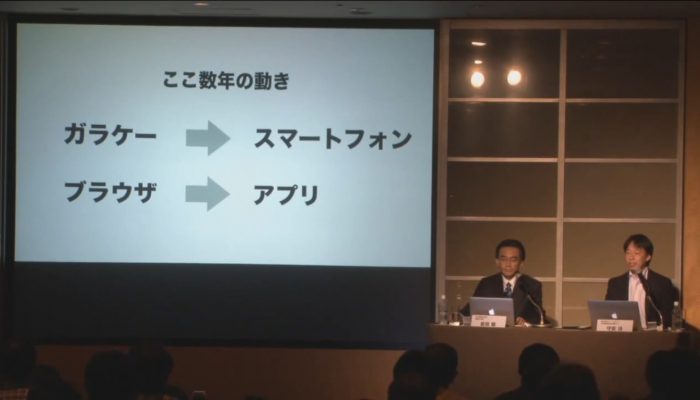 “We have to take the approach that encourages consumers to retrieve information at their own will.”
“We have to take the approach that encourages consumers to retrieve information at their own will.”
☆ NintendObs Event – Nintendo Q3 FY3/2015 Q&A.
Question:
My question is about the company’s internal marketing structure. It seems that New Nintendo 3DS has had a good launch in the U.S. and Europe, but focusing on the year-end sales season, I get the impression that Nintendo could have done more. For example, Nintendo may have had more of the chance if the launch of New Nintendo 3DS in the U.S. and Europe was in time for the year-end sales season, or Nintendo could have struck more of a balance between handheld devices and home consoles because home consoles tend to perform weakly when handheld devices are strong. I believe Nintendo plans to provide new services and diversify its business, but I would like to know specifically how you plan to change the marketing structure, or if there is no need to change it, do you think that your current sales and marketing structure can keep up with the changes that you explained in this presentation?
Answer:
Iwata:
I think that each of our activities, whether it is product development, marketing or providing constantly evolving services, has unique issues it has to address. For example, if developers tended to think that even though they had created good products, incompetent marketing team members were the cause of poor sales or if, on the other hand, the marketing team members thought that the products were not selling well because the developers had made unappealing products, then we would be seen as a bad company with a culture in which everyone tends to lay the blame on someone else. Since such an organization should never exist, I have been encouraging everyone internally to first consider what more they themselves can do. A company is a group of people, so it is impossible to completely eliminate these kinds of opinions in challenging circumstances, so I repeatedly make this kind of remark internally. This is not something I would usually say externally, but I thought I should share this internal message with you today.
To your question about our marketing issues, many of the people who are now leading the marketing teams have had the experience that products sell well if awareness is built through TV advertisements, so it is inevitable that they have a tendency to continue proven methods from the past. However, this does not mean that the managers of the current marketing division are being adamant and inflexible. On the contrary, everyone is conscious that they have to change. Recently, as you know, Nintendo has been taking new approaches such as making use of social media, utilizing our own direct consumer channels like “Nintendo Direct,” and digitally taking pre-orders soon after disseminating relevant information through “Nintendo Direct.”
The notion that products sell well if we run big TV advertisements or make attractive (discount) offers in sales seasons is no longer accepted. We are in the process of trying our utmost to push forward the change with the firm understanding that the channels in which people obtain information and the conditions to convince consumers are changing greatly, and so we must also change. So far, we have only been able to show partial results, and we need to reflect on a number of issues from the year-end sales season last year.
Regarding New Nintendo 3DS, the quantity that was produced before the end of last year or the amount that was delivered to consumers, was limited, and overseas, in Europe or the U.S. for example, it takes longer than in Japan for the products to be produced in China and to actually arrive and be lined up in stores. Hence, we had to make a difficult decision on whether it was acceptable or not to cause a worldwide shortage of New Nintendo 3DS. As a result, (based on the different diffusion levels of the preceding models,) we made the decision to launch it in 2015 in Europe and the U.S. In hindsight, the actual results and the reactions to the launch of New Nintendo 3DS tell me that you are absolutely correct in assuming that the results would have been different if it were launched within 2014. In addition, the fact that putting effort into attracting attention to New Nintendo 3DS became an obstacle to selling Wii U in Japan has made us once again understand the difficulty in staggering the sales peaks. We have many issues to reflect on, and I think we could have tried harder. However, beyond that, I believe that although the traditional practice of selling things and the belief that products will sell well if you advertise broadly and make attractive discount offers, worked five or ten years ago, it is no longer applicable in this present day.
Consumers will purchase high quality products even if they are expensive, or in other words, even if there are slightly reasonable discount offers, consumers will not purchase products unless they truly understand and are satisfied with the quality. Also, product appeal must be properly communicated to consumers, but advertisements that are pushed on consumers are gradually losing their effect, and we have to take the approach that encourages consumers to retrieve information at their own will. We are in the middle of such changes, and I think that completing this transition process will be one of the prerequisites for regaining Nintendo-like profits by the fiscal year ending March 2017, which I previously mentioned.
In addition, we have product development issues to be addressed. The development side must consider why a certain game is not selling well even though the game is fun to play, and the Metascore and User Score are high. I believe that if they were to blame it all on the marketing side, we would make no progress at all. Rather, our developers must ask themselves whether the game’s appeal can be communicated to consumers at a glance, it can be explained to others in a way that is easy to understand and whether it is easy to invite other people to play the game, because if the product includes aspects that sell themselves, it has the potential to become a smash hit. For example, “Minecraft” is a game that a very large number of people around the world are playing and it uses user-generated content to keep people interested, and one after another, players are inviting others to join them. We also think that one of the major reasons why the handheld game device business has been doing comparatively well in Japan is that consumers teach and learn from one another while playing wireless multiplayer Local Play. We have started to do various things such as holding our own events and supporting fan community events in attempt to bring the fascination of wireless multiplayer Local Play to the U.S., which is predominantly an automobile society, and to European cities, which are not as automobile dependent as the U.S., and many people use trains and other means of public transportation. After repeating such events, we have gradually started to see a positive effect. I feel that one of the main reasons that “Monster Hunter 4 Ultimate” had such a good start overseas was that members of the core community spread the good word about it, and thus, the initial sales figures were two or three times more than the last “Monster Hunter” game. I think that the approach we are taking is gradually starting to show positive results. I believe that the products themselves should have such attributes, and I also think that we should change the way we sell the products. Regarding the constantly evolving services that I just mentioned, there is a constant stream of breaking news on the Internet and new videos are uploaded to it and are being played every day, and the content changes by the second. As for packaged video game software, however, the structure of video games in the past was that once the game software was developed, it is done with, and the only thing left to do was to deliver it to consumers. However, will our current consumers, who expect everything to change by the day, truly be satisfied with this structure?
We cannot put unlimited amounts of energy and power into one product, so our challenge is how to embark on new endeavors efficiently with limited investment, while having consumers notice the difference. I plan to explain this topic when I talk about how we will make use of smart devices, and I believe that we have to undertake all of these efforts together as a set. When not only the marketing issues that you have pointed out but also the product development and service operation issues are skillfully solved, the value of Nintendo products will be more adequately conveyed, more people will appreciate this value and spread the word, and as a result, we should be able to return to a “content is king” situation, where the people who make genuinely interesting products sell more, so I would like to surely address these issues.
— Third Quarter Financial Results Briefing
Source: Nintendo JP.
At NintendObserver, the comments are on Discord.
Click on Community to learn more. 🙂
…
…Wanna play? Buy a Wii U.
And if you’ve already got yours, here are all the games already available on the platform. 😀



